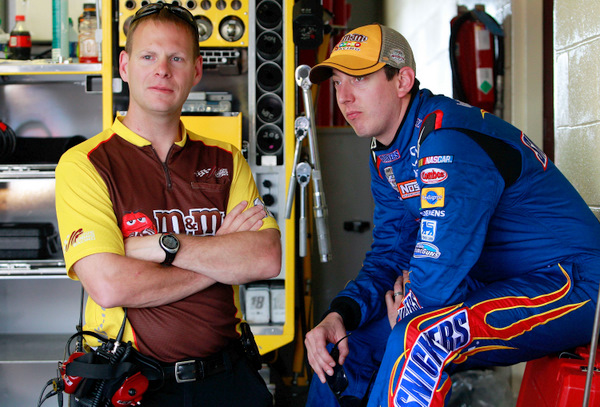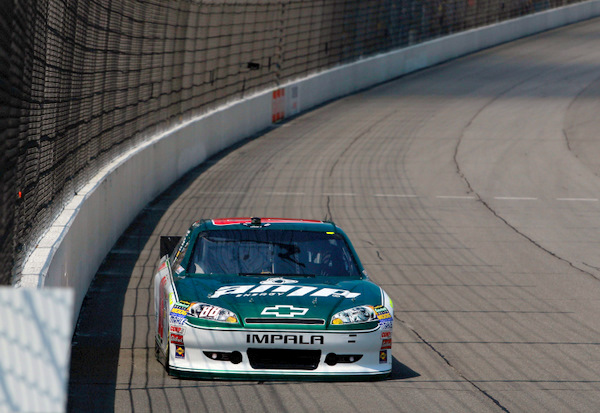New asphalt? No sweat...

It's been a rough few weeks for Kyle Busch (R) and crew chief Dave Rogers (Photo: Getty Images for NASCAR)
By Mike Mulhern
mikemulhern.net
But the nightmare of that Daytona 500 pothole last year, right in the middle of the sport's leadoff event, still looms over all these track bosses. No one wants that embarrassment.
So Roger Curtis, the guy who runs things here at Michigan International Speedway -- and who gets praise from those who have known him for so long as one of the NASCAR men 'who really gets it,' and prefers substance over flash, unlike some of the tour's promoters -- has lined up the machinery.
And the parent International Speedway Corp. is okay with the $7 million price tag.
Repaving this 18-degree two-mile track would seem fairly straightforward. It's been done before – when it was built in 1968, and again in 1977, 1986, and 1995. And NASCAR has a crackjack bunch of repavers on the payroll now, who have successfully done half a dozen major track repaves lately.
Still, remembering how the racing itself can change dramatically when a track is repaved – Darlington at 200 mph into those 1960s corners, the mix-and-match two-man drafting at Daytona – it's best to keep an eye on what may play out here.
First off, the new asphalt will logically be extremely smooth, which accentuates aerodynamics. Will this place, with its own 200 mph corner speeds already, become a new mini-Daytona, with two-man packs dominating? Wonder if teams now have their simulation computers programmed for that possibility?
Repaving here didn't come out of the blue. Goodyear says it's been talking about it for a couple years now, considering the harsh, heaving Michigan winters. (The Detroit area potholes, especially out on the Interstates, are frighteningly horrendous, and potentially deadly.)
And Curtis says he'll be keeping the character lines of this place…which all-in-all should be one of the showcase places for NASCAR racing, instead of a gas mileage game as races here have become over the past few years. Maybe the new asphalt will alter that part of the game here.
"We made it a special point to talk with Tony Stewart," Curtis said, with a grin. "And he was happy to hear we're not reconfiguring."
The most significant challenge, Curtis anticipates, is the weather. "That's why we're starting with pit road right after this race. Work done is work done.
"Then, right after the August race, we'll hit the ground running, taking down the Safer walls and doing the milling, doing as much as we can before Thanksgiving, because the weather is undependable in the springtime.
"We're milling off the surface, two layers down; we're not tearing up all the pavement. A factor was 'is there time to get all this work done?' We're confident the team from Ajax can get it done. And we're confident we'll have plenty of cure-time.'"
The top two inches of the existing asphalt will be removed, and replaced by 'two lifts' of asphalt, each 1-1/2 inches thick, as a leveling course and final wearing course.
All totaled, about 650,000 square feet of asphalt will be removed, and 22,000 tons of new asphalt will be laid.
A laser 'survey' of the track has already created some 100 million data points, for reference, and it turns out the track has already has a bit of 'variable banking,' which helps drivers find different grooves.
Still, repaving Michigan? There are other tracks which would seem to be more in need…with drivers pointing to last week's stop at Pocono for one. "Maybe they could truck some of the extra asphalt over there," Greg Biffle cracked.
Curtis concedes "We could probably get by with another year (before repaving). But after the problems we saw at Daytona, why take that risk? It's not worth the trouble."
Repaving tracks used to be so problematic. But now they're almost routine. The use of polymer-modified asphalt cement, with its elevated softening points, has been key.
Back in the early 1990s here there was a major issue with the asphalt tearing up in turn three – the jet dryers damaged the asphalt -- and repaving that patch was done quickly, and sacks of white lime had to be spread on the new asphalt to help speed curing….which made for an interesting race, with white clouds floating up off the track.
But now, after repaves at Homestead, Richmond, Martinsville, Talladega, Darlington, Daytona, and Phoenix (currently underway), this Michigan job should be relatively uneventful.
Each track has a finite life to it. So there is a rotation to this. And it's the big temperature swings that make for problems.
Heat, hot weather, is fine; it's cold that hurt.
Goodyear's Greg Stucker is confident his men can have a tire ready: "Like any repave, you get more grip, so we would expect speeds to jump up.
"One advantage is that they're not changing the configuration. We know what to expect with banking and turn radii.
"We'll be able to do some testing on their 'test strip' (on pit road), and get a feel for where we are, relative to some of the other repaves we've seen lately.
"We'll still need to get on the track and do the testing, but we'll have a leg up. Not sure if they intend to have it all completed before the winter hits or not. But we'll get on it as soon as we can in the spring."
Faster? Logically. But that depends on what tires Goodyear picks.
The key will be to deal with the increased tire temperatures. "You're always concerned on a repave, because there is a lot of grip and the surface doesn't generate a lot of wear," Stucker says. "So the tire doesn't get abraded off (a process which effectively helps cool the tire)."
More grip and smoother.
"Just like what we saw at Talladega a few years ago," Stucker says.
"We're just going to come with the right package for the configuration, and usually that winds up being faster.
"One thing we've noticed with repaves is there is not a lot of (speed) fall-off (over a 100-mile run). You don't see a lot of change between a new tire and a used tire."
Carl Edwards can sympathize with Joe Gibbs' drivers, Denny Hamlin, Joey Logano and Kyle Busch, for their current issues with NASCAR over those trick engine oil pans, which officials confiscated Friday.
Edwards has had some similar issues to deal with.
And Edwards has an interesting take on it all:
"The best way I can explain it is that I am on the President's Council for Fitness, Sports and Nutrition.
"There is a big vetting process that goes with that. I had to be on a 30-minute phone call about every bad thing I have done in my life.
"They really wanted to talk about these times that our team had been caught cheating.
"They were like 'Why were you fined these points and this money? You guys were cheating.'
"And I am like 'No, you don't understand. This is auto racing. The guys at the shop build the most trick thing they can and bring it to the track. I hop in and drive it. And if some part falls off or the heights aren't right, then it looks like we were cheating. But that is just part of the sport.'
"It is hard to explain that to some people. They think if it didn't fit the rules then I was cheating.
"I thought that was humorous -- that I was on the phone with the White House and they couldn't understand I had no clue the right-rear corner was low or the oil cooler lid had fallen off…."
Edwards should be one of Sunday's favorites here; he's had one of the hottest cars on the tour all season, though still only one win.
But car owner Jack Roush is already looking ahead….not just to 2012 but to 2013, when NASCAR teams will be running 'new-look' stockers, with more street-identity.
And Roush says Ford is ready to roll out its first version of the sport's new 2013 Cup car, which is set to run under the Mustang logo. What the three other manufacturers have planned is apparently not that far along yet.
Roush says the new cars will sport 'a common roof,' among all makes, though with different quarter-windows. The rear deck will be common too, though the rear bumper will be different. The wheel wells and part of the front-end will also be common to all four car makers, but he says the sides, quarterpanels and fenders will be brand-identifiable.
Roush says NASCAR is trying to 'aero-match' downforce and drag, to keep the four makes in the same aerodynamic ball park. But he says that part of the new game is still under development.

Michigan's asphalt looks pretty good. But why wait for a pothole? (Photo: Getty Images for NASCAR)
© 2010-2011 www.mikemulhern.net All rights reserved.
Web site by www.webdesigncarolinas.com







New Asphalt Not A Bad Thing
The speed issue is certainly a serious one, but it's more its own issue as opposed to just being related to new pavement. 186 for stock cars at MIS, that's absurd, over 15 MPH too fast. MIS' asphalt looks okay but one can also see the bumpiness, so putting on a fresh new coat of asphalt hardly seems worth controversy.
If anything I agree Pocono should be repaved (at least in the corners) as well. I busted out my tape of the 1996 Pocono 500, the first race there after it was repaved, and the extra grip allowed for some downright astonishing racing; aside from the patented crossover lead-changes Pocono has seen over its history the '96 Pocono 500 at times looked like a Talladega drafting race.
Someone else half-jokingly said that Michigan repaved could allow the 2-car superdraft like Daytona did; I doubt 190-plus Michigan speeds would allow superdrafts but after seeing Keselowski trying it with Trevor Bayne on a couple of occassions I'd certainly hope for it and can see where it is conceiveable here.
Post new comment